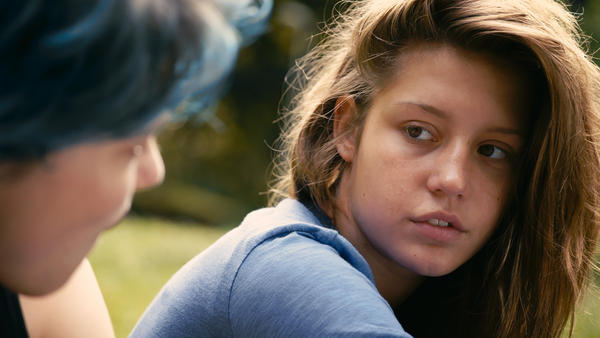Movie review by Greg Carlson
Following its Palme d’Or win at the Cannes Film Festival in May, the discourse around Abdellatif Kechiche’s “Blue Is the Warmest Color” has addressed the off-screen drama between the filmmaker and stars Adele Exarchopoulos and Lea Seydoux as much or more than the onscreen story of a doomed love affair in Lille, France. Claims of Kechiche’s bullying, abusive on-set behavior led the moviemaker to respond with thinly-veiled legal threats. Additionally, author Julie Maroh, whose 2010 graphic novel is the basis for the film, expressed her own disappointments with the adaptation, writing that the filmmaker’s vision “turned into porn and [made] me feel very ill at ease.”
Subsequently, a number of writers have taken positions on the movie’s sexual and emotional politics. Michelle Juergen’s “PolicyMic” essay “’Blue Is the Warmest Color’ Gets Lesbian Sex Wrong” was reposted on “Salon” and frames an attack on Kechiche’s dominant male gaze. Juergen argues that the director failed to uphold the “responsibility that comes with representing both another gender and sexual preference.” Writing for “Jezebel” and taking the opposite side, Ashton Cooper notes, “I have never seen a portrayal of a lesbian relationship on screen that captures the experience as truthfully as this film has.” Somewhere in between is the valuable October 25 “New York Times” critique by Manohla Dargis, perhaps the best thing about the film written so far.
The movie’s three hour running time suggests an epic of sorts, and Kechiche makes a convincing argument on behalf of the protracted character study. The erotically charged bildungsroman is so close to the heart of Gallic moviemaking that Molly Haskell, in an essay on Maurice Pialat’s “A nos amours” wrote that the “teenage girl on the cusp of sexual awakening is a beloved icon of French cinema.” Haskell went on to say, “Painful, beautiful, and discomfiting, ‘A nos amours’ remains… startling in its honesty, its unique mix of savagery and delicacy,” a description that could just as easily be applied to “Blue Is the Warmest Color.”
The relationship between Exarchopoulos’s Adele and Seydoux’s Emma provides the platform for the movie’s explorations of domestic and interpersonal conflict, but without question, the fullness of the story belongs to Adele and Adele alone (the French title of the film is the less colorful but more appropriate “La Vie d’Adele – Chapitres 1 & 2). Assisted by cinematographer Sofian El Fani, Kechiche stays in close, framing Exarchopoulos in tight shots that regard the range of emotions on Adele’s face. Kechiche’s relentlessness forms a perfect illustration of the phenomenon of the “polyphonic play of features” described by Bela Balasz in his groundbreaking “Theory of Film” in 1948.
“Blue Is the Warmest Color” is filled with richly detailed moments, many of which could stop a clock: a commentative assist from Louise Brooks in “Pandora’s Box” during a backyard celebration party; the volcanic and physical post-confession brawl that leaves Adele a sobbing mess; the way Adele labors to keep it together at a preschool dance program; Adele and Emma’s brief, wrenching reunion at a café. “Blue Is the Warmest Color” is not perfect, but the collaboration between Kechiche, Exarchopoulos, and Seydoux demands attention. The expression of Adele’s neediness, desperation, and anguish at love lost should move anyone who has ever been on the receiving end of a brutal breakup.
